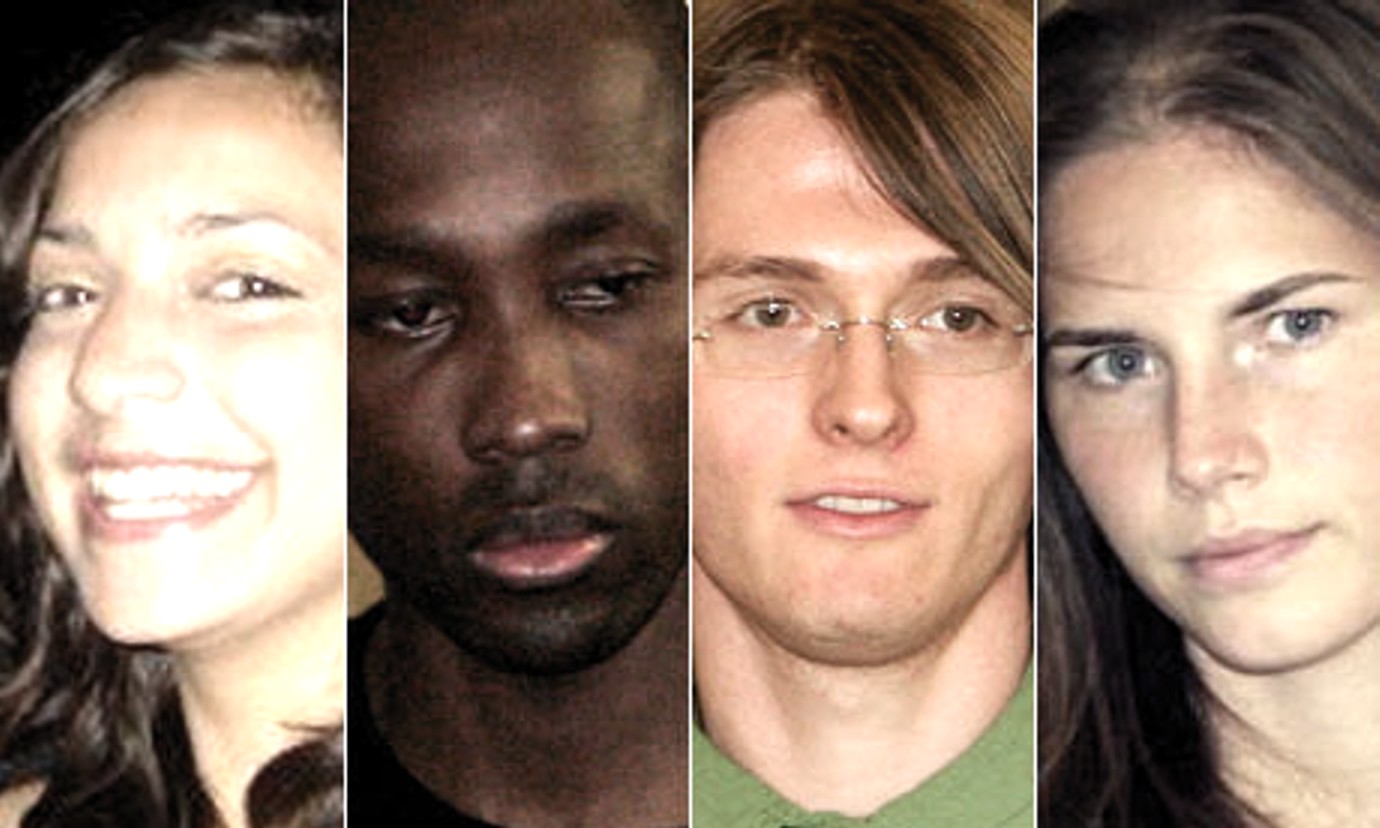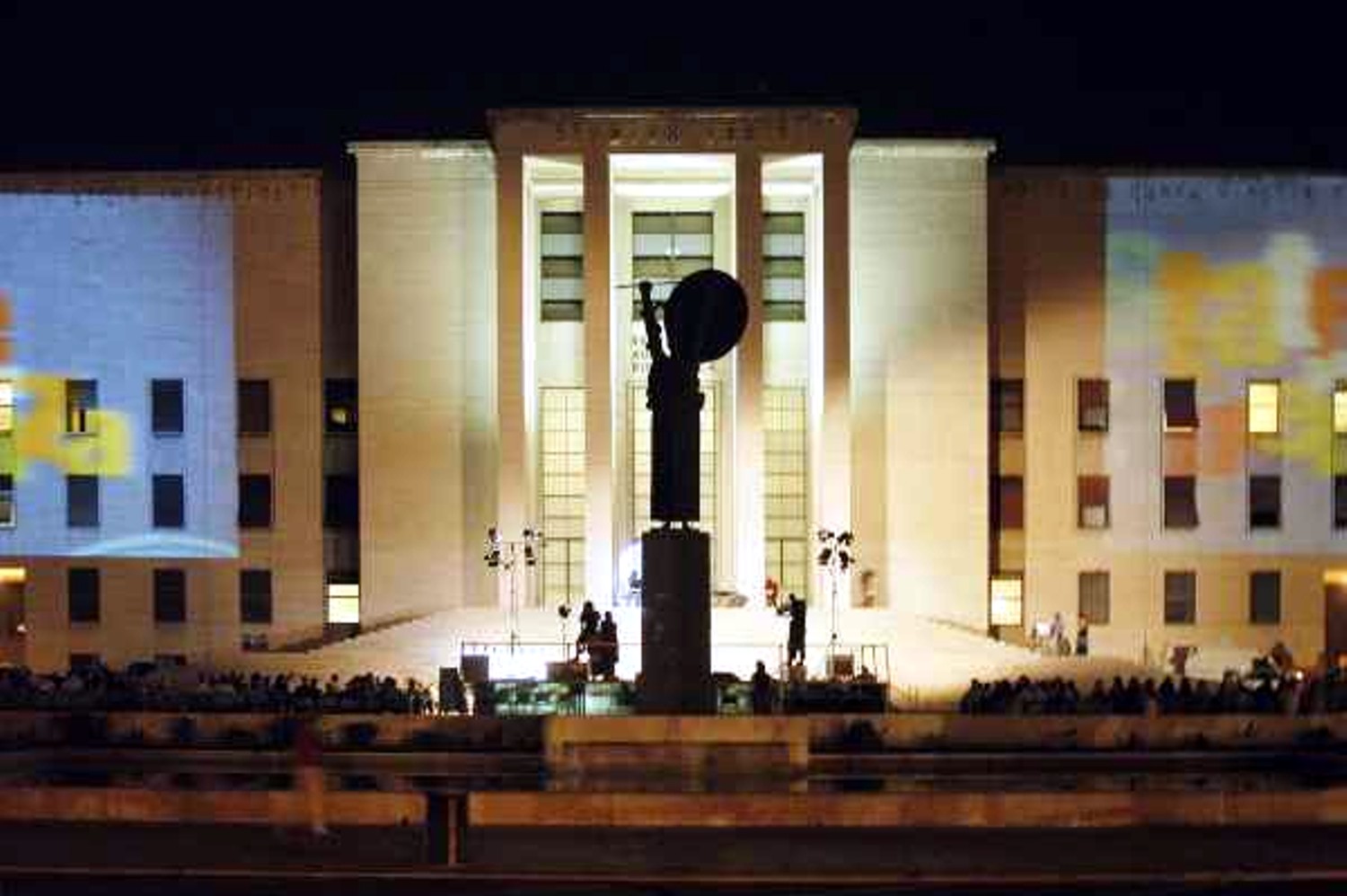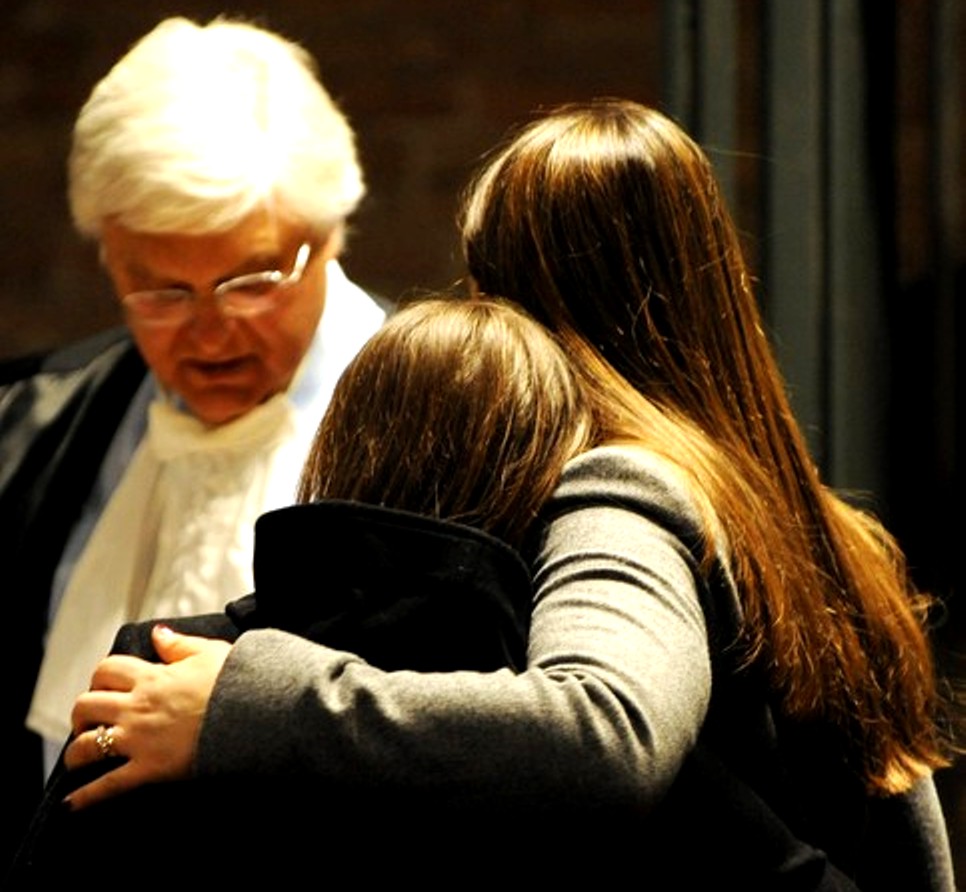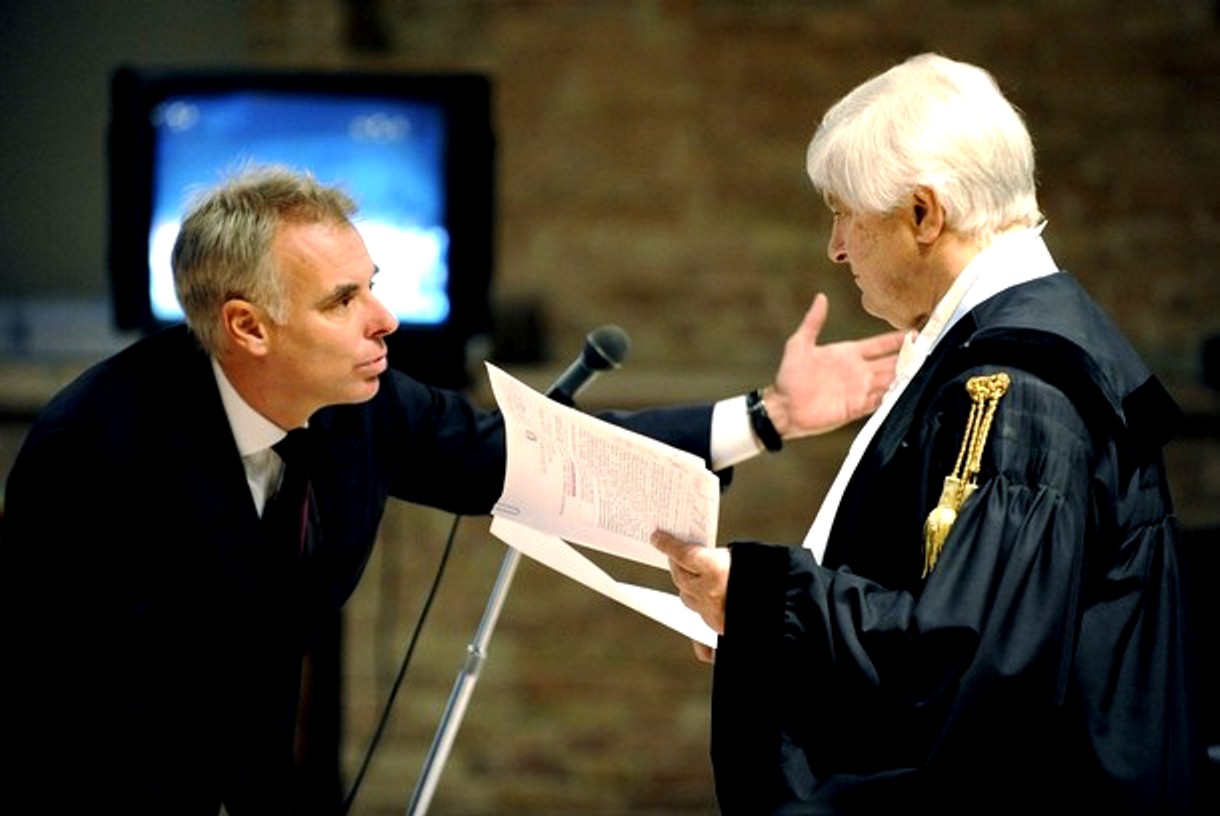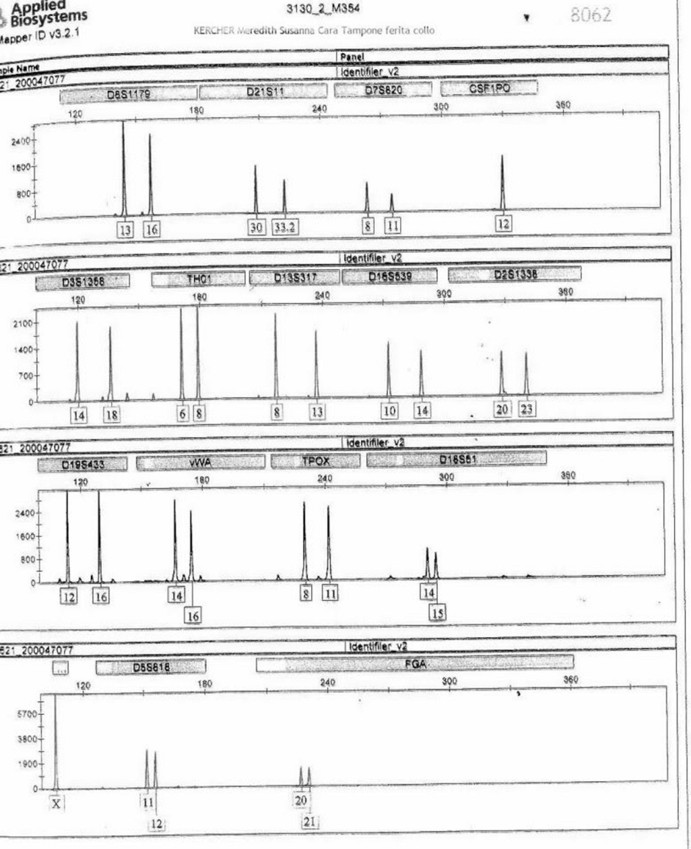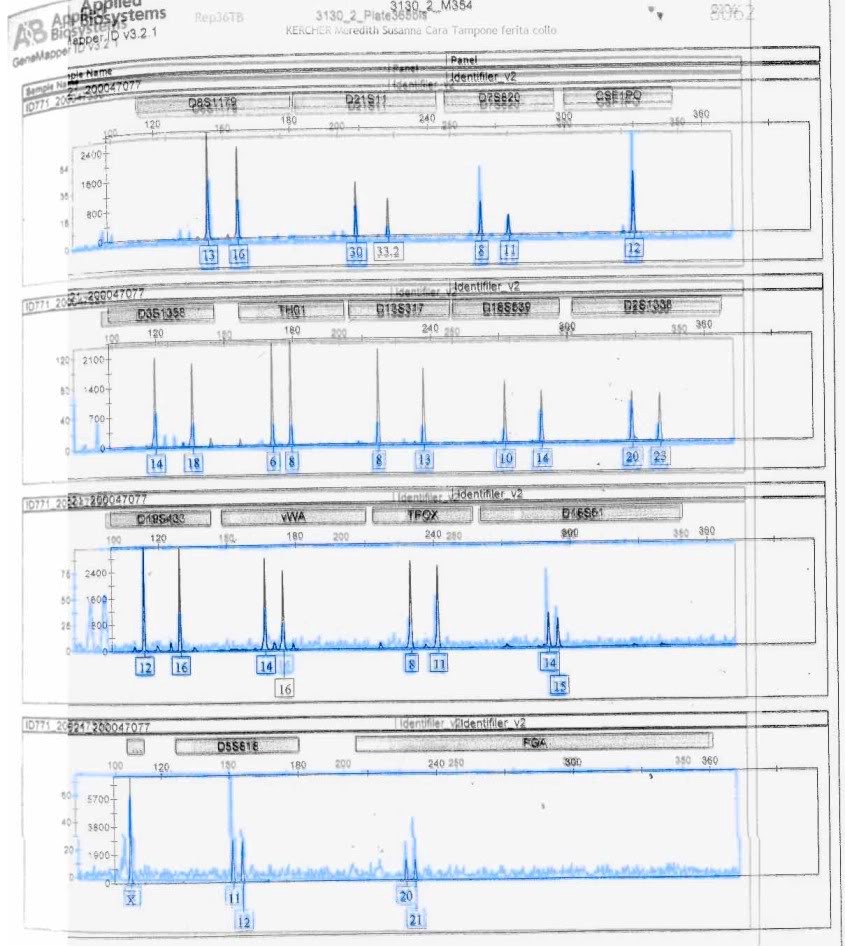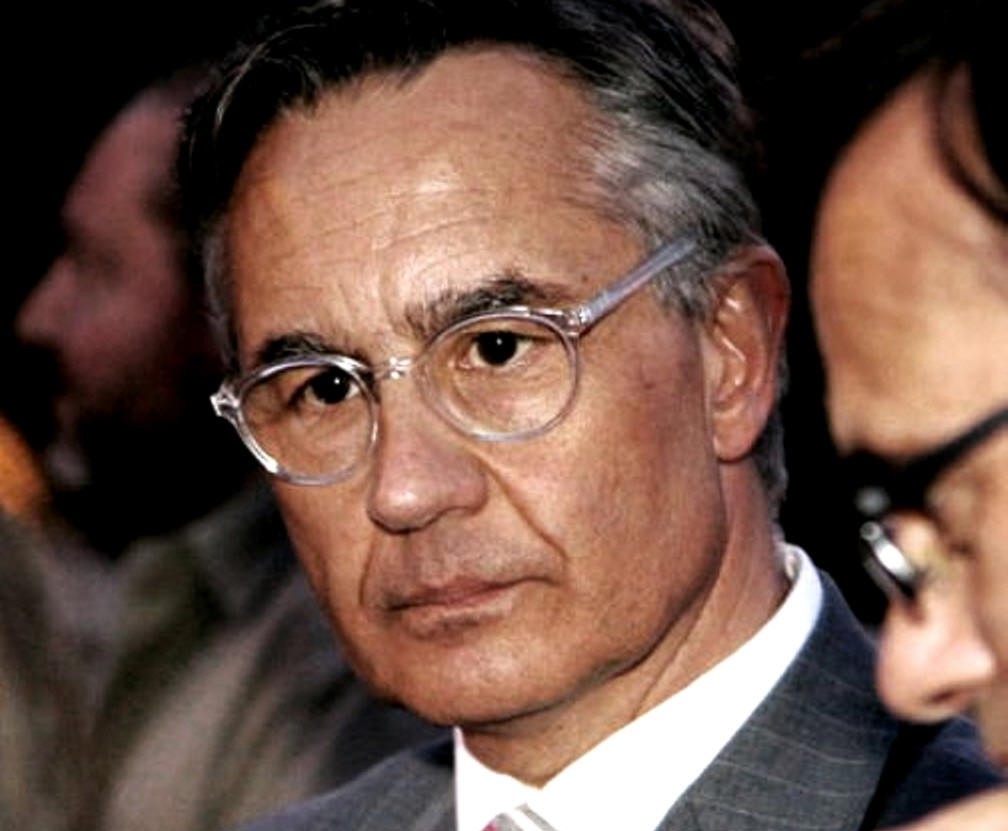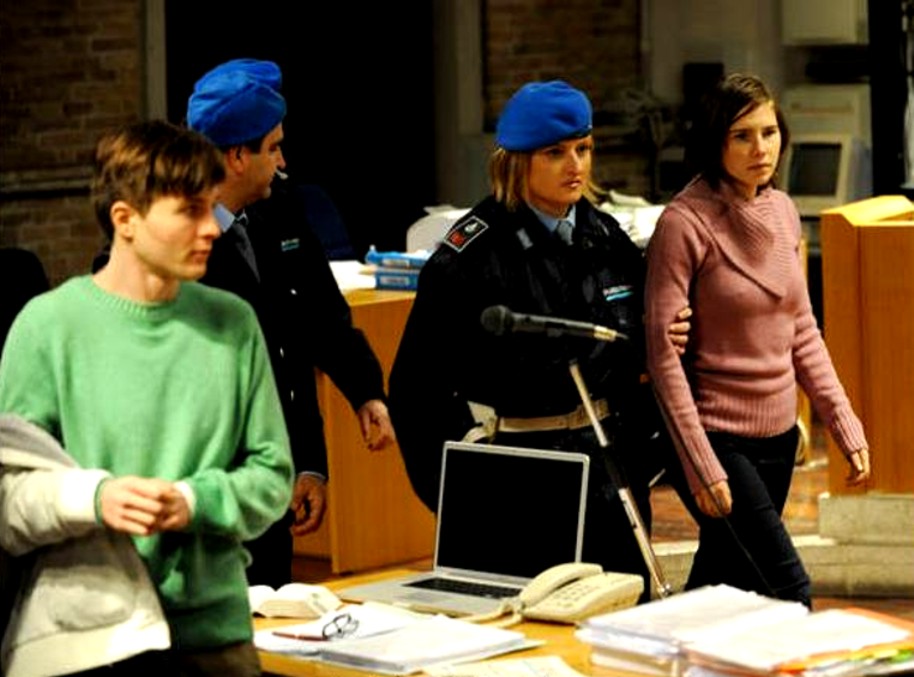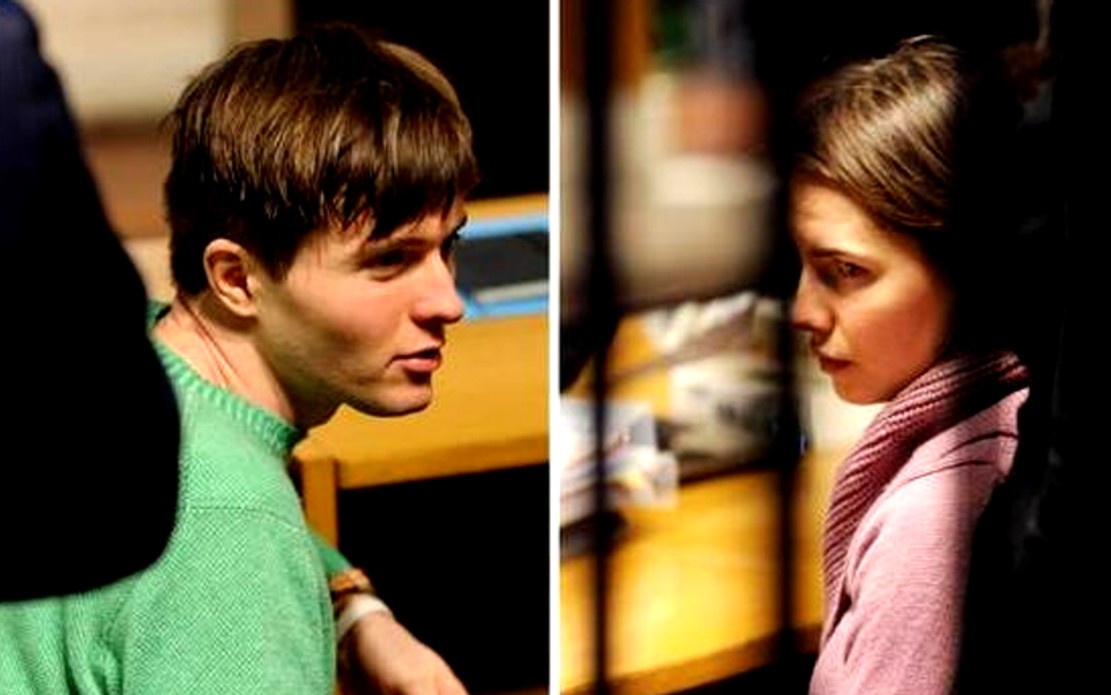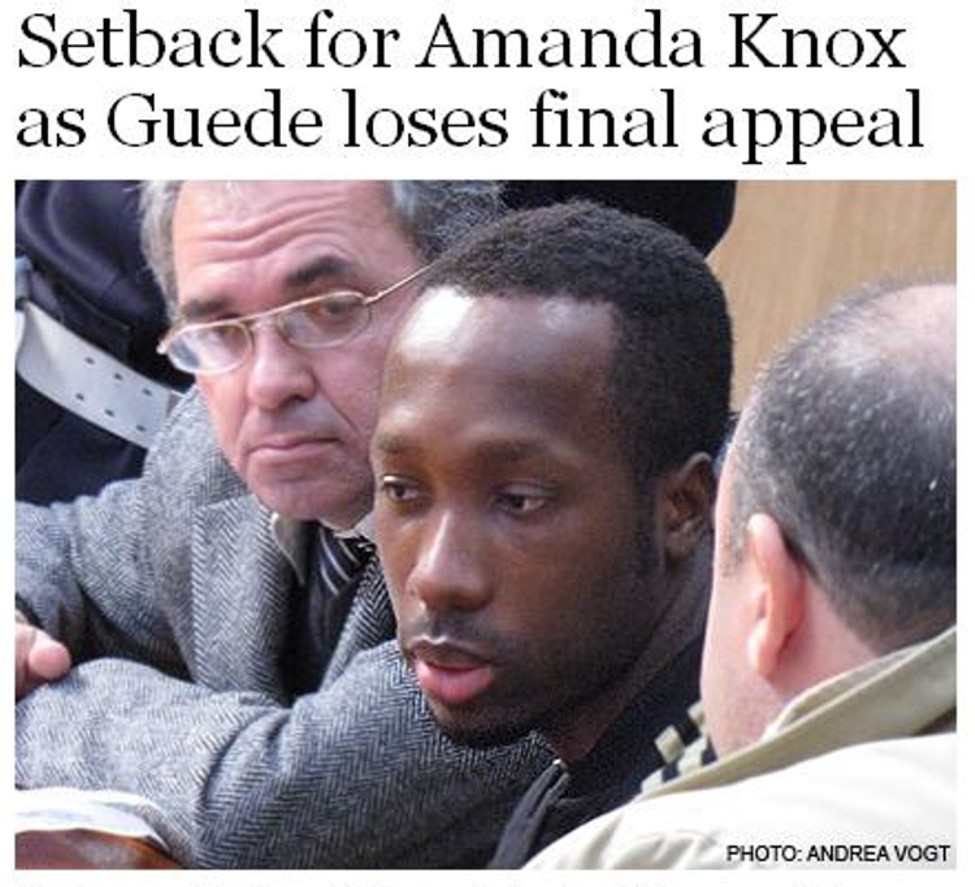
Category: Hellmann 2011+
Monday, February 28, 2011
Andrea Vogt: Supreme Court Report Highlights Amanda Knox Mention To Mom She Was There
Posted by Peter Quennell
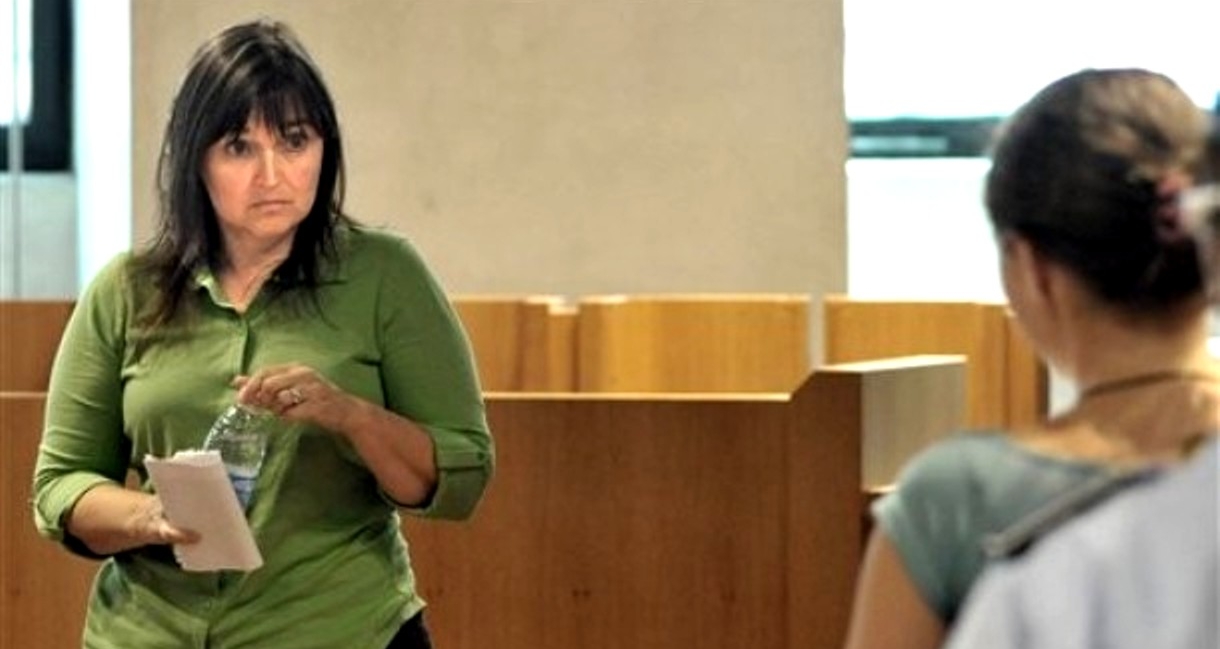
[Above: Amanda Knox and her mother in courtroom when Edda Mellas testified 19 July 2009]
Andrea Vogt in the Seattle PI translates from the Cassation Report described in our two previous posts.
A sentencing report just released by the highest Italian appeals court sheds new light on why so many Italian judges have maintained Amanda Knox was involved in her roommate’s murder.
The document, among others, cites a conversation Knox had with her parents while under surveillance during a prison visit in which she said “I was there,” apparently referring to the night of the murder.
Amanda Kox’s remark was recorded at Capanne Prison and was long public knowledge, but that the Supreme Court listed it among other evidence of involvement in this report is significant. The report summarises what is the evidence against all three, especially that against Rudy Guede.
The court…said that based on the 43 wounds to Kercher’s body (and the time it would take to inflict them) that it was… probable that Guede and two others forcibly held Kercher down, threatened, taunted and eventually fatally stabbed her.
The Court’s quoted language is extremely hard and gives a sense that the judges were appalled. The Court’s report has been out in Italy for over four days now - but the Seattle PI’s is the first extensive US or UK media summary.
The US and UK media have a pretty consistent habit of ignoring these inconvenient reports.
Saturday, February 26, 2011
Very Hard Language Of Supreme Court In Rejecting Guede Appeal, Confirming Three Did It
Posted by Peter Quennell
The report of the Supreme Court of Cassation released on Thursday was foreshadowed in content in our post of 17 December:
Rudy Guede’s appeal is rejected on all ten grounds. His appeal grounds were ugly and dishonest and he has no further appeal. He will serve his 16 years, with maybe some time off, for being a savage willing party to the cruel stupid murder of Meredith.
Rudy Guede will go down in infamy for his sex crime against a defenseless victim, for being a party to a taunting torturing knife attack, for claiming Meredith invited him in for consensual sex, and for not calling for help for Meredith and maybe saving her life while it was still possible.
Cassation continues the fine Italian court tradition in this case of taking a firm and unblinking position, and for being utterly oblivious to the vile over-the-top campaign of Curt Knox, Edda Mellas and David Marriott which may now haunt Amanda Knox all of her life.
What really caught the Italian media’s attention and made this the second most widely reported development in the case after the Amanda Knox-Raffaele Sollecito verdict was the icy hard language, the pure contempt for the depraved pack attack, the total rejection of all Guede’s stories, including his oft-repeated and totally unbelievable claim that Meredith invited him in and wanted love-making, and the court’s conclusion once again that the evidence methodically described in the Micheli Report overwhelmingly proves that THREE perpetrators took part in the crime.
The Court of Cassation in this report made clear that Knox and Sollecito are not already formally nominated as the other two perpetrators and it does wait the referral of the outcome of the present appeal in Perugia. But unless the defense witnesses Alessi and Aviello can indeed convince Judge Hellman’s appeal court that Guede attacked Meredith with friends or that some other people entirely carried out the attack, there seems no way out for them.
The court also indicated that it considered the motive of the attack on Meredith to be frivolous, which is precisely what the prosecution claims in the current Perugia appeal as grounds for rejecting Massei’s mitigating circumstances, and for increasing Knox’s and Sollecito’s prison sentences to life terms.
This post of a month ago further explains Knox’s and Sollecito’s almost insurmountable problems.
The written report from Cassation on that December 2010 decision on Guede’s final appeal (due soon), plus Judge Micheli’s Sentencing Report for Rudy Guede of January 2009, plus all that associated evidence, now gets automatically ported by law straight into Knox’s and Sollecito’s appeal.
Judge Micheli took a hard line toward Rudy Guede, and he sentenced him to 30 years. He also remanded Knox and Sollecito to trial, and his report explains the basis for that remand.
Judge Micheli’s remorseless and tightly argued report (see summaries below) very comprehensively backed up his decisions. (Later reductions in sentence were automatic and they flowed from the terms of Guede’s short-form trial, and some controversial mitigating circumstances advanced by Massei for Knox and Sollecito.)
The prosecution’s appeal against the Knox and Sollecito sentences argues that the acceptance of mitigating circumstances by the Massei court should be thrown out, and that Knox and Sollecito should be subjected to a longer sentence. Remember that even in the case of Alessi’s wife, who was not even present when he beat the kidnapped baby to death, she received a sentence of 30 years.
So here is how it is stacking up:.
For the prosecution, four courts including the Supreme Court of Cassation have ruled that three people participated in the crime against Meredith, plus all of the evidence from both the Guede and Knox Sollecito trials now comes in, plus the prosecution is appealing for tougher sentences, which seems well justified based on precedents.
And for the defenses? Will they now feel they have no choice but to put Knox or Sollecito or Alessi or Aviello or for that matter Rudy Guede on the stand as a last-ditch manoeuvre?
Hard to see what further they have to lose.
Saturday, January 22, 2011
Fourth Appeal Hearing: Updates On Today’s Court Hearing Which Is Mainly Procedural
Posted by Peter Quennell
Above: Sapienza University is the largest European university and the oldest of Rome’s three state-funded universities.
- At noon Italian time ANSA reported that the two DNA experts from Sapienza University have been given 90 days to do their retesting. They will begin their review on Feb. 9, conclude by May 9 and report their findings to the court on May 21.
- The witness in the square on the night who said he saw Sollecito and Knox, Antonio Curatolo, will be re-examined. This is at the prosecution’s request, not at the defenses’.
- The DNA experts have asked to break open the handle of the knife they are asked to retest. If Meredith’s blood is found to have seeped into the handle, by itself that will be case closed and verdict confirmed. Decision on hold.
- The examinations will be carried out in the presence of representatives of all parties. Among them will be Dr. Patrizia Stefanoni, the technical director of the forensic laboratory that conducted the original DNA investigations.
- The prosecution requested Rudy Guede as a witness and that too was put on hold. Yet another shot across the bows of the defense. If Alessi or Aviello are put on the stand then Guede will also be there to heatedly rebut them.
- The next appeal hearings scheduled by the court of appeal have been set for 12 and 26 March, and April 16 and May 21. May 21 is when the DNA experts will report back so just three days for examination of witnesses.
Judge Hellman is allowing no defense fishing expeditions, and he is giving the prosecution full latitude. Good reason for Giulia Boingiorno not to be in court: her baby was delivered today in Rome. We like her and wish her and the baby well.
Below, images of the two court-appointed DNA experts and of Amanda Knox. The Reuters caption says her lawyers are consoling her. Chris Mellas’s remarks later made it sound like the family is already trying to let her down gently.
.
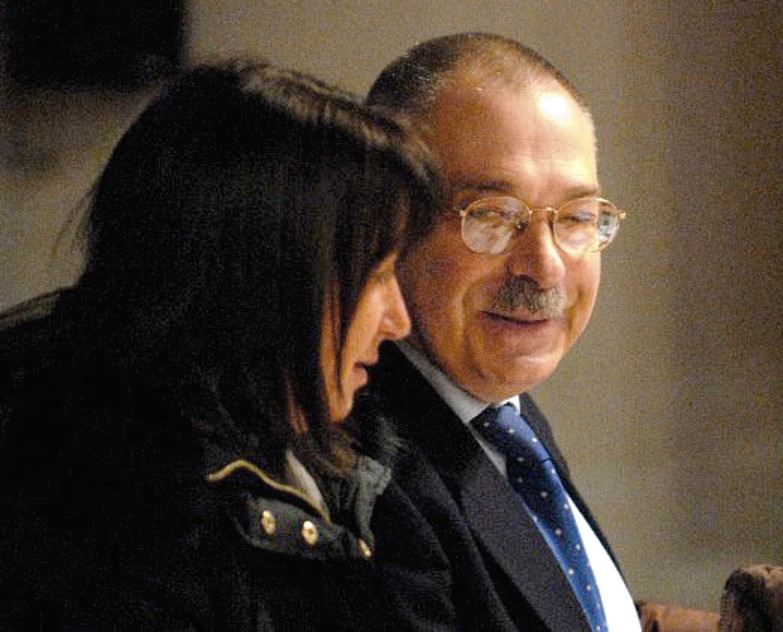
The Fourth Appeal Hearing Today Saturday: The Main Items On The Court’s Agenda
Posted by Peter Quennell
Not very much drama is expected. This hearing is mainly organizational.
The mood of the defense lawyers will be interesting to watch. Also whether Sollecito lawyer Giulia Bongiorno is a show or a no-show. And we may find out if the possible defense witnesses Mario Alessi and Luciano Aviello will actually testify.
Two DNA experts nominated by Judge Hellman at the last appeal hearing on 11 December for the genetics testing of the bra clasp and the knife will appear and be sworn in and charged with their assignment.
Stefano Conti and Carla Vecchiotti of La Sapienza University in Rome will be asked how long they believe they will need and it is expected that they will ask for two to three months.
And the court will establish a timetable for the testimony of several new defense witnesses who may challenge one or two components of Antonio Curatolo’s statement. Nick Pisa bizarrely mis-reports on this in the Daily Telegraph:
He had told the court he remembered the night “clearly” as he saw student revellers queuing up to catch buses to nightclubs on the outskirts of the city.
However defence lawyers have established that he could not have seen the students, as the night Meredith was murdered was a bank holiday with venues being shut and no buses running.
Have established that he could not have seen the students? Really? There were other buses than the disco buses running that night. Students were definitely around.
If prisoners Mario Alessi or Luciano Aviello are indeed put on the firm list to testify that’ll be a pretty sure sign that the defenses are really clutching at straws, as in each case their known claims are contradicted by dozens of evidence points .
The prosecution has interviewed both of them and those interviews have not been made public. Here are more wrong and seemingly irrelevant claims bizarrely reported by Nick Pisa.
Retired British university professor David Anderson, who lives near Perugia and who has taken an interest in the case, said: “The conviction of Amanda and Raffaele is scandalous as neither has the psychological profile of a killer.
“The investigation was flawed from the beginning with many mistakes being made and there is no DNA, no real motive, no weapon and no credible witnesses at all.”
Wednesday, December 22, 2010
The El Bizarro Defense: “It’s Unfair To Use The DNA They Didn’t Manage To Scrub Away Against Them”
Posted by Cardiol MD
Remember the twins who appealed for mercy at their trial for murdering their parents? On the grounds that they are now orphans?
There is something of that reminiscent here. The defenses of Knox and Sollecito seem to be trying to exclude evidence that they themselves tried to destroy, essentially on the grounds that their destructive attempts failed to destroy all of it, and left behind only some of it.
Their argument boils down to whether the disputed DNA evidence is more unfairly prejudicial than probative. The faux forensic experts who are arguing in the media that this disputed DNA evidence would not ever be admitted in US or UK courts are in fact totally mistaken.
It is my opinion that because it was the defendants’ deliberate conduct that nearly succeeded in extinguishing all their DNA, any US and UK courts would insist to admit this highly relevant evidence, and let the participants duke out its fairness, in open court, in front of a jury.
That is what the only relevant court in Meredith’s case, the Perugia appeals court, is now doing.
DNA evidence may be “only circumstantial” but that is as with most of the evidence in this case. Meredith was murdered - that’s a fact - but no one saw who did it except the killers.
Judge Hellman designated his selected Expert Reviewers with such alacrity that I think he had already thought it all out. Judge Hellman is being prudently responsive to the legal and political pressures bearing down on him, and knows the ruling also calls the defendants’ bluff.
As Tom in the post below and others are pointing out, the review is limited to a very partial review of the DNA evidence, and what is not to be reviewed is by far the most significant.
The possibility of more residual blood at the blade/handle junction is thought-provoking. Sollecito’s obsession with knife-ownership suggests that his knife, the murder-weapon, would be top quality, probably with a handle/blade junction, pretty, but vulnerable to seepage into it.
Also, the knife-wielders significantly, even deliberately, stayed away from the well-known neck-blood-vessels, the Jugular Veins, and the Carotid Arteries, on both sides, focusing their neck-stabs on the area of the Larynx, as if they had some medical knowledge of what they were doing - but not enough.
The blood-vessel they did cut - the right superior thyroid artery - is a branch-of-a-branch of the better known blood vessels, but very close to the larynx. They didn’t know, or care, enough to anticipate the lethal consequences of cutting so small an artery in that particular location, so near to the airways.
I agree with others that Judge Hellman may also be innoculating himself by heading off a possible adverse ruling of the Supreme Court in Rome, which must be restricted to Procedural/Legal issues.
The defence lawyers sem to be submitting, probably against their own better judgement and advice, to the FOA camp’s insistence for additional review. I also believe the defendants will bitterly regret this insistence.
Monday, December 20, 2010
The Limited DNA Reviews - Why They Probably Won’t Help Defense And May At A Stroke Be Game Over
Posted by The Machine
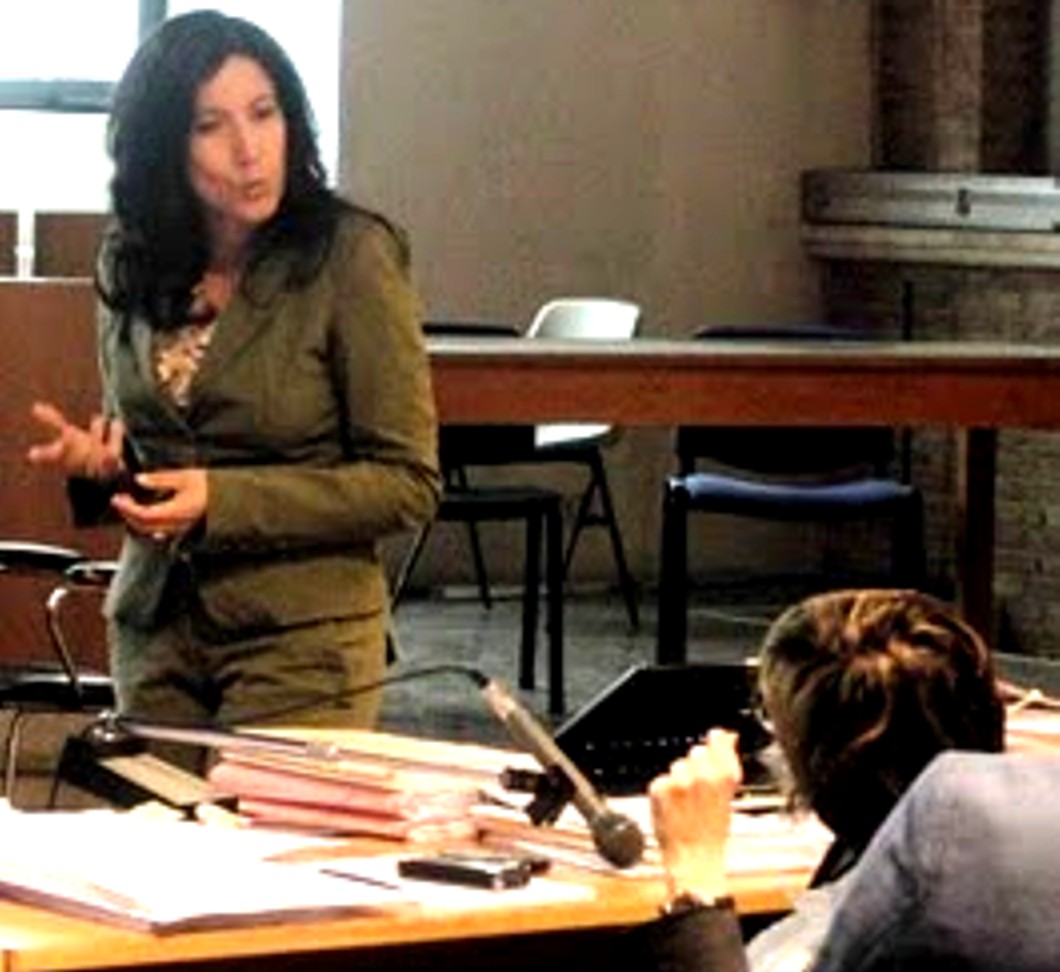
[Above: Dr Stefanoni at trial respoding to a question from Sollecito’s defense team]
Amanda Knox and Raffaele Sollecito and their families were jubilant at Judge Claudio Pratillo Hellman’s decision to allow an independent review of some key forensic evidence.
Two experts from Rome’s Sapienza University - Professor Stefano Conti and Professor Carla Vecchiotti - have already been nominated by the appeal court (they will be confirmed in January) to do an independent review of the forensic evidence.
Late saturday and sunday many of the journalists covering Meredith’s case saw Judge Hellmann’s decision as a major victory for the defence teams. Several giddy journalists even reported that somehow Amanda Knox had won her appeal.
However, two very important facts were lost in all the hullaballoo surrounding Judge Hellmann’s decision about this independent review..
First, the original forensic investigation and tests already were carried out by independent experts. Dr. Stefanoni and her team were from Rome, and they worked for another arm of the government. They weren’t hired by the prosecution to blindly confirm their suspicions that Amanda Knox, Raffaele Sollecito and Diya Lumumba were involved in Meredith’s murder.
And many people seem to be unaware of the fact that it was not Amanda Knox recanting her false accusation, but the DNA testing work of Dr. Stefanoni and her team that led to the release of Diya Lumumba. In this case Dr Stefanoni has high credibility.
Second, a number of experts have ALREADY carried out independent reviews of the DNA and forensic evidence and some of them have testified at court hearings in the course of 2008 and 2009.
In this post, we will take a look at some of the experts involved in the original DNA tests and the subsequent reviews and consider the implications of the new review, including some possible unexpected stings in the tail.
1) The Original Tests
Dr. Patrizia Stefanoni is one of the leading forensic experts in Italy and she was part of the the Disaster Investigations Teams sent to identify victims of the south Asian tsumani in 2004. She had to pass a series of stringent state tests to join the scientific police in Rome. She led the forensic investigation into Meredith’s murder and was responsible for carrying out the DNA tests and interpreting the results.
The Double DNA Knife
Dr. Stefanoni found seven traces of human flesh (human tissue cells) on the large kitchen knife sequestered from Sollecito’s kitchen. There was only enough DNA for one test. However, the results of non-repetitive tests are allowed to be entered as evidence in Italy.
The defence teams are notified of the date and time of all non-repetitive tests to make sure that they can be present to observe that correct procedures are adhered to. If they miss the tests or don’t stay for the full (often long) duration they have not carried out their full mandate to their client (they might even be liable for malpractice) and the defense has no right to claim wrong procedures or lab contamination.
Dr. Stefanoni testified at the trial that the one test she did “reliably” identified the DNA as Meredith’s.
Italian TJMK poster and DNA specialist Nicki explained in May 2009 why the DNA on the blade of the knife was a definite match to Meredith’s DNA:
Two genetic profiles are identical and therefore belong to the same individual if a) they are in the same position, and b) they have identical shape and dimension. In this case, each peak produced in the original samples exactly corresponds to the peaks yielded by the knife sample, position, shape and dimension.
[Below: DNA on the blade of the knife(top chart), Meredith’s DNA(second chart), and the two superimposed]
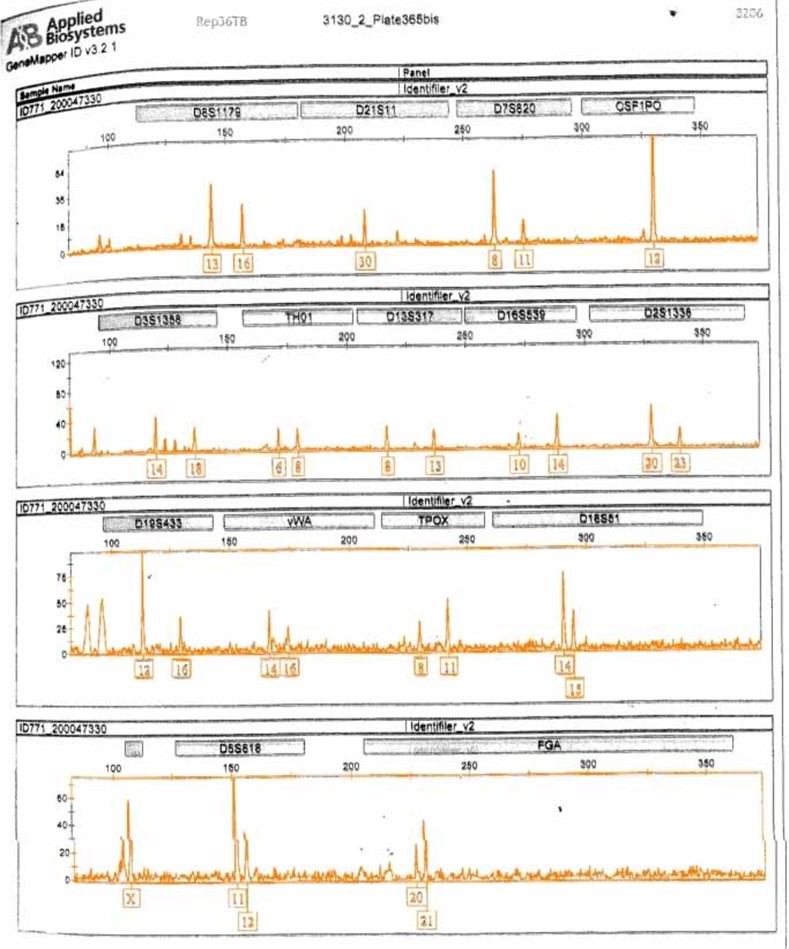
The Bra Clasp
Sollecito’s DNA on Meredith’s bra clasp was identified by two separate DNA tests. Judge Massei rejected defence claims that Sollecito’s DNA was LCN DNA and noted that there was no reason to doubt the reliability of the result:
It has already been said that Dr. Stefanoni had reported that on the [bra] hook (Exhibit 165B) the mixed genetic profile attributable to the victim and to Raffaele Sollecito was found; looking at the electropherogram, the ratio had been estimated in the proportion of 1 to 6 (the victim’s DNA being six times that of Sollecito); the quantity of DNA found could not be considered terribly small because there were several peaks that easily exceeded 1000 RFU, and no [317] repetition of the analysis had been carried out because the peak height of the smaller fraction of DNA was good, such that there was no reason to doubt the reliability of the result.
2) Independent Reviews
Dr. Renato Biondo
There was an independent review of the forensic evidence in 2008.
Dr. Renato Biondo, the head of the DNA unit of the scientific police, reviewed Dr. Stefanoni’s investigation and the forensic findings. He testified at Rudy Guede’s fast track trial in October 2008 and confirmed that all the forensic findings were accurate and reliable.
He also praised the work of Dr. Stefanoni and her team. “We are confirming the reliability of the information collected from the scene of the crime and at the same time, the professionalism and excellence of our work.”
Professor Francesca Torricelli
The Kercher family hired their own DNA expert, Professor Francesca Torricelli, and asked her to examine the DNA evidence.
Professor Torricelli is the Director of a genetic facility at Careggi University Hospital and has been working in genetics since 1976. She testified at Knox’s and Sollecito’s trial last and she also confirmed Dr. Stefanoni’s findings.
She told the court that the significant amount of Sollecito’s DNA on Meredith’s bra clasp meant that it was unlikely that it was left by contamination. She also agreed with Dr. Stefanoni that Meredith’s DNA was on the blade of the double DNA knife.
General Luciano Garofano (image above)
Distinguished DNA expert and former Caribinieri General Luciano Garofano analysed the DNA and forensic evidence for the early 2010 book “Darkness Descending”.
He has more than 32 years of forensics experience and is a member of the American Academy of Forensic Sciences. In his section of the book he explains at length why he too thinks that Knox and Sollecito are guilty of Meredith’s murder.
In an interview with The Sun’s Nick Francis, he said that the right people had been convicted: “I believe the police have prosecuted and convicted the right people, even if they got some of the details wrong.”
He told reporter Andrea Vogt that there wasn’t enough evidence to overturn Knox’s and Sollecito’s convictions: “I do not believe that there is enough evidence to convince an Italian magistrate and jury to overturn this conviction”.
Dr. Anna Barbaro
Rudy Guede’s defense lawyers hired their own forensic expert, Dr. Anna Barbaro, and asked her to examine the DNA evidence.
She didn’t dispute the DNA evidence against Guede, Knox or Sollecito. Guede’s lawyers claim that there was an innocent explanation for his DNA being at the crime scene and that Knox’s and Sollecito’s DNA implicated them.
Guede lawyer Walter Biscotti noted that the evidence against Knox was particularly strong.
3) The original prosecution team
Both Prosecutor Mignini and Prosecutor Comodi said after the appeal session on saturday that they are are confident that the independent review of the DNA and forensic evidence will confirm the sentences and verdict.
Mr Mignini
:
I don’t agree with the request and I see it as a waste of time. The judge did not criticise the methods that were used to collect and test the DNA….. The review was granted because the jury needed help to interpret the findings as they are difficult to understand. I don’t see how it is a victory for the defence, as the methods were not criticised in the ruling. The review will confirm the sentence and the verdict will stand.
Ms Comodi
As far as I am concerned this independent review will just confirm the excellent work carried out by the police scientific unit. The judge did not actually explain why he was allowing this review and although I do not agree with it I am sure it will underline the job originally done.
4) Two possible game-overs
Re-examination of the knife
In “Darkness Descending” the former Carabinieri General Garofano wrote that the police should have separated the plastic handle from the knife and checked for blood there.
The defence teams will regret having asked for the independent review if the new experts do this and they find there a testable quantity of Meredith’s blood.
Re-examination of the bra clasp
According to the authors of “Darkness Descending” Dr. Stefanoni found highly suggestive evidence of Amanda Knox’s DNA on Meredith’s bra. Raffaele Sollecito’s forensic expert, Professor Torre, also claimed that he had found Knox’s DNA on Meredith’s bra strap.
It seems that another forensic expert Vincenzo Pascali ALSO found Knox’s DNA on Meredith’s bra. The reporter Barbie Nadeau wrote the following:
Vincenzo Pascali, the chief forensic consultant who was set to give expert testimony about the possible contamination of the bra clasp, walked off the case last month, reportedly leaving a €50,000 bill. Back in September, Pascali, who declined to comment for this story, hinted that the clasp also contained Knox’s DNA.
And so in conclusion
One to two years later DNA testing techniques have improved, and also there is the sleeper of what is under the handle of the knife.
The defence teams’ insistence on an independent review could really explode in their faces if the new experts confirm more of Meredith’s DNA on the knife (Knox’s DNA is there very strongly) and that Knox’s DNA is on Meredith’s bra.
Saturday, December 18, 2010
First Reports On Scope Of Appeal Sounds Like Maybe A Setback For The Defenses
Posted by Peter Quennell
The first full reports are not out yet. This is a first quick take on the Italian reporting and may be subject to correction.
Some of the Cassation’s hard-line decision for rejecting Rudy Guede ‘s 10 appeal grounds in Rome on thursday will indeed be accepted into this appeal for the judges’ consideration.
The judges are agreeing to the defense request for a review of the testing of the DNA on the bra clasp and the large knife, though of course nobody - nobody - so far has ever proved contamination as the prosecutors today pointed out.
Two Rome experts in DNA have already been nominated.
Apparently none of the other very extensive forensic evidence at the scene of the crime - which is the entire apartment, not merely Meredith’s bedroom - is to be retested. That has always been very tough to explain away.
Apparently only one or two of the previous witnesses whose testimony is described in the Massei report will be heard from again. Possible Guede confidant Alessi will be allowed and maybe Aviello who claimed his missing brother really did it.
And apparently ninety days is added to the allowed duration of this appeal, because the Massei Report took 90 days to produce. The deadline now is next September, although if it lasts through to the spring we will be surprised.
The defense doesn’t seem to have many strong hopes going forward. No more Spiderman attempts on Filomena’s window. They found no room for appeal with regard to the various contradictory alibis, the various peculiar phone calls, and assorted bizarre behaviors.
Remember that even Knox and Sollecito themselves have claimed they were zonked out of their skulls on the night - though magically they seem to have managed a major cleanup and rearrangement of the entire crime scene, minus evidence pointing to Guede.
The astute commenter Piktor posted this on PMF
The expert review would be needed if the scientific results were the only evidence that convicts.
What if the DNA evidence was thrown out. Could you convict without it?
You have the staging, the lies, the false accusation, the police testimony, the defendant’s multiple alibis that don’t mesh, Mrs. Mellas testimony in court exposing Knox’s willful “confusion”, the email and diaries.
You add it up and it all points in one direction. No doubt about the result.
The prosecution narrative makes sense. The defence has no narrative.
The Appeal’s Set Limits: What The Judges Allowed Today And Didn’t Might Tell Us A Lot
Posted by TomM
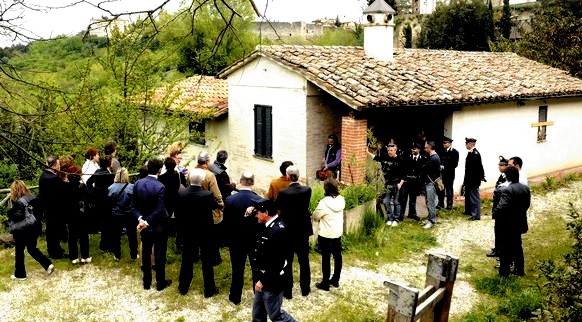
[Massei court deciding whether to buy spiderman theory; they didn’t]
1. The Context Of These Remarks
The judge ruled on the appeal’s inclusions and exclusions today. I’ll summarise what they are and how American courts might have differed.
I really do not understand why the defense and the family are so happy with this review, which is very limited and not complete in any sense - other than, perhaps, the “any port in a storm” phenomenon.
From my view in the bleachers, there are way more risks to the defense than to the prosecution from Saturday’s rulings.
2. What’s Allowed In Italian Appeals V. American
As a California lawyer familiar with trials and appeals in my state, watching the Meredith Kercher murder trial wind its way through the Italian legal system has been a learning experience.
It is a system with more protections than the one I know first-hand. The case is now in its first appeal phase, and proceeds far differently from the way it would in the US.
- If Knox and Sollecito had been convicted in an American court (which an American court would have had no difficulty in doing) less helpful presumptions would be applied to their appeal.
- In Italy they are convicted, and for that reason they are imprisoned and the visitation privileges they had before the jury’s verdict have been reduced. But for purposes of weighing the evidence in the appeal, they are presumed innocent.
- In the US, the court of appeal would not presume them innocent or guilty; it would regard them as having been adjudged guilty.
- In Italy, they can ask for the court of appeal to hear testimony from new witnesses and seek to introduce additional evidence.
- In the US, the appeal would be on the basis of the clerk’s and reporter’s transcripts of the trial. In the US the jury at the original trial would have been instructed that if an item of evidence can be interpreted two ways, one favoring guilt and one favoring innocence, they should accept the interpretation that favors innocence. But not so on appeal; the court of appeal would interpret all the inferences from the evidence in the light most favorable to the prosecution.
- An American court of appeal would not consider an attack on the credibility of a witness unless the testimony was such that no reasonable person would believe the testimony.Thus, an attack on the testimony of Curatolo would have no chance of success on appeal. In fact, jury instruction in the US would give the jury blessing to believe him even absent disco buses running that fatal night.
From a form jury instruction on how to judge witness credibility:
“Do not automatically reject testimony just because of inconsistencies or conflicts. Consider whether the differences are important or not. People sometimes honestly forget things or make mistakes about what they remember. Also, two people may witness the same event yet see or hear it differently.”
The Italian appeal is described as a “trial de novo”.
- In common law jurisprudence, a trial de novo is simply a new trial, and the jury in a new trial would not even be told of the existence of the first trial. It would be done as if the first trial never happened.
- Not so in Italy. The jury and lay judges have full access to the case dossier, the Massei Motivazione, and the briefs of the parties. They decide which parts of the case should receive new evidence, and the parts where none is needed. If that were not the case, they would not know how to respond to the defense requests.
3. Tellingly, What Court Has NOT Re-opened
1. Staging Of Burglary
It is significant that there is no re-visit on the staging of the burglary. This charge is not just one of the things used to prove the murder, it is also a separate charge which does not require that a person also have participated in the murder.
Let’s suspend disbelief a moment. Suppose AK and RS had not been present during the murder, having ducked out briefly to get more drugs, but returned to discover Meredith’s body.
Suppose they thought they would be suspects because they had let Rudy in and feared they would be blamed, so they staged the burglary to divert suspicion from themselves. In this hypothetical situation, they are still guilty of staging a burglary even if they didn’t otherwise participate in the crime.
So, what to make out of the fact that no further evaluation will be made of the staging?
This seems like the easiest of the charges to prove and the most difficult to defend. Staging is a recognized phenomenon in criminal investigations and the defense expert did not fare well under cross-examination. I don’t see how the court would reverse the judgment on this issue given the state of the record.
2. Collection Of DNA
Defense criticized the way the dna was collected from the bidet, but there will be no review of that evidence - or of any other of the mixed blood/dna evidence - only the knife and the bra clasp.
If the appellate jurors’ inclination were to think there is reasonable doubt on the dna, there is plenty of defense expert testimony to hang that hat on. That only two of the exhibits will be studied shows that they do not question the work of the scientific police as a whole.
4. The Pattern Of Sorts In These Rulings
From my own experience, I firmly believe that Hellman has not made up his mind on the final outcome. That doesn’t mean he doesn’t know what he thinks the jury will do with the case.
He clearly knows the case, and I think he knows if there are areas in Massei’s reasoning that have vulnerabilities (not necessarily fatal) that could attract attention in the Court of Cassation.
I think he knows whether the prosecution’s case is a house of cards, or if it is a good case with some curable cosmetic flaws.
To me, the rulings look like the judge has reviewed the case, thinks it is fundamentally sound, and believes it will be backed up by unbiased expert opinion - and if it doesn’t, he will assess what impact that has on the case.
The issue with respect to the scientific police is not that they were biased in the sense of falsifying evidence to wrongfully convict, but that the video of the crime scene investigation showed non-textbook acts, Stefanoni didn’t leave a complete paper trail in testing the knife, and they failed to collect and correctly bag the bra clasp at the beginning.
All of which left an opening for the defense to claim the dna evidence is suspect. There is a reason why teachers don’t let students grade their own papers, I think that concept is behind Hellman’s decision to seek an unbiased review of these two items.
5. No Signs Of Exoneration In Rulings
If Rudy Guede testifies and gives a believable narrative, it may not matter what the two dna reviews say, and it might also undermine the jurors’ inclination to accept the theory of remorse from the covering with the quilt that persuaded Massei to reduce the sentence.
An increased sentence is not out of the question.
As I said at the top, I really do not understand why the defense and the family are so happy with this review, which is very limited and not complete in any sense - other than, perhaps, the “any port in a storm” phenomenon.
The bra clasp evidence is not going to go away, and there is the risk that increased technical sophistication could result in identifying a complete dna profile of Amada Knox on it. If they disassemble the knife, there could be abundant blood between the handle and the blade.
Again, from my view in the bleachers, there are way more risks to the defense than to the prosecution from Saturday’s rulings.
Friday, December 17, 2010
Stinging Guede Final Appeal Rejection Suggests Trouble For Knox and Sollecito
Posted by Peter Quennell
Rudy Guede’s appeal is rejected on all ten grounds.
His appeal grounds were ugly and dishonest and he has no further appeal. He will serve his 16 years, with maybe some time off, for being a savage willing party to the cruel stupid murder of Meredith.
Rudy Guede will go down in infamy for his sex crime against a defenseless victim, for being a party to a taunting torturing knife attack, for claiming Meredith invited him in for consensual sex, and for not calling for help for Meredith and maybe saving her life while it was still possible.
Cassation continues the fine Italian court tradition in this case of taking a firm and unblinking position, and for being utterly oblivious to the vile over-the-top campaign of Curt Knox, Edda Mellas and David Marriott which may now haunt Amanda Knox all of her life..
This is clearly not a final court of appeal that is now going to turn on a dime and say when they hear the final appeals of Amanda Knox and Raffaele Sollecito, oh, of course, we got that previous decision wrong, and of course Guede did it alone.
Here is the cool clear report of Andrea Vogt, this time being published in the UK’s First Post. The highlights:
1) On rejecting Guede’s ludicrous tale.
Put simply, no judge or magistrate has believed Guede’s story that he was in the bathroom of the apartment the two girls shared in Perugia, listening to music on his iPod while someone else stabbed Meredith.
According to Guede’s story, when he came out of the bathroom he found Meredith bleeding to death and tried to staunch the flow of blood ““ hence the discovery of his DNA by investigators.
2) On the huge new risk now for Sollecito and Knox.
Under Italian law, all documentation from Guede’s various hearings can now be introduced into the appeal trial of Knox and her former boyfriend, Raffaele Sollecito, which reconvenes in Perugia tomorrow.
The problem for Knox and Sollecito is that Guede’s trial documents will include the judges’ reasons for convicting Guede and denying his appeals: namely, that they believe all three ““ Guede, Knox and Sollecito - killed Meredith together.
3) On Kercher family lawyer Maresca possibly demanding Guede testify
“Guede can now be called to testify and we are considering, along with the prosecutors, if we will request that Saturday or not,” said the Kercher family’s attorney Francesco Maresca in Rome.
“We will ask that the high court decision be admitted, as it stabilises the facts and is an important point of reference, with judges confirming the reconstruction of events and the involvement of the other two suspects in this dramatic ordeal in which a young woman lost her life.”
If Guede is called, it is unclear whether he would be considered a reliable witness given that no court has believed his story so far. And the situation is further complicated by conflicting stories about Guede’s take on Knox and Sollecito.
4) On the prospects for requested defense witnesses Alessi and Aviello
Guede is also the subject of a mysterious 10-page letter from prison, written on blue notepaper in the feathery script of convicted child murderer Mario Alessi, and now sitting in a lawyer’s office in Parma.
Alessi claims to have heard the real story of what happened while stuck in a prison cell across from Guede. Three other inmates signed each page of Alessi’s letter bolstering his story - that Guede said repeatedly in his cell and the prison yard that Knox and Sollecito had nothing to do with the crime. (Guede denies the conversations)...
Will the judge overseeing Knox and Sollecito’s appeal in Perugia request it? If he does, it could be entered into evidence alongside further controversial letters, these from a Neapolitan mafia snitch named Luciano Aviello. Aviello claims that his own brother killed Kercher…
Since Knox and Sollecito were convicted and jailed a year ago.. these stories of intrigue have found their way out from behind the prison walls across Italy, from the sex offender ward in Viterbo to the high security penitentiaries in Prato and Turin.
5) And on John Kercher’s recent strong protest against the profiting from Meredith’s death
Meredith Kercher’s bereaved family this month broke a three-year silence to speak out against Knox’s “minor celebrity” status and the high-profile publicity campaign her family and supporters have been waging to claim wrongful conviction.
Thursday, December 16, 2010
As Amanda Knox Via Her Statement Has Now Placed “Will She Testify?” Front And Center…
Posted by Cardiol MD
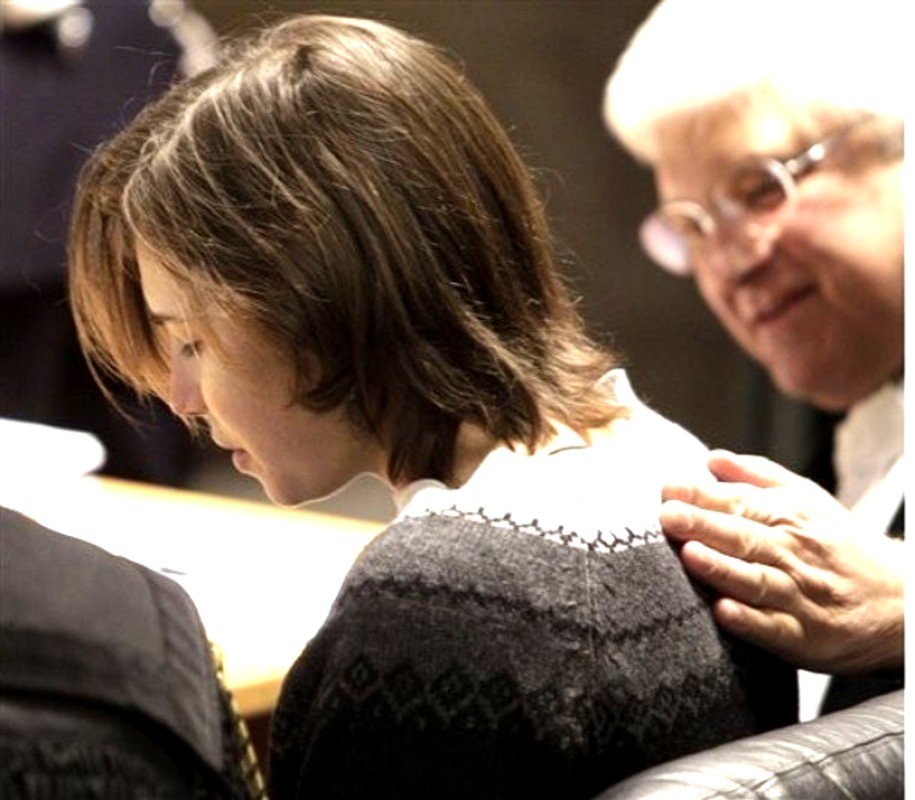
She sure has created an interesting cliffhanger.
Last Saturday Amanda Knox spoke from her seat beside her defense team and she was not subjected to cross-examination.
If she does choose to mount the stand to back up her claims with some testimony, she will be subject to cross examination, as will Raffaele Sollecito.
What may the judges and lay judges be allowed to deduce if neither of them mount the stand, or alternatively refuse to answer?
This involves the legal concepts of the Privilege against Self-Incrimination, the Right to Silence, and the Right to Lie.
In the US prosecutors are prohibited from commenting adversely on a defendant’s Exercise of the Right to Silence at trial, on the argument that doing so would violate the privilege against self-incrimination.
But this may be circumvented as demonstrated in the Duke lacrosse-team rape frame-up by the prosecutor.
The DukeLax prosecutor (echoed by many others in Durham and elsewhere) falsely alleged, publicly, a lacrosse-player “wall-of-silence” as persuasive evidence in favor of guilt, even when he knew full-well that the Laxers had transparently cooperated with prosecutorial investigators.
So much for “enshrinement” of the right to silence in the US.
There is no argument that in all three countries, Italy and the US and the UK, criminal defendants have the right to remain silent. This means that they do not have to speak in their own defence, if they choose not to do so.
However, Italy takes the privilege against self-incrimination such a giant step further that a guilty defendant, if given the choice, might be wise to choose trial in Italy, in preference to trial in either the US. or the UK.:
First, there is a significant difference between the use of the word “testify” in Anglo-American common law and its use in Italian law. Iin the former a testifying-defendant is sworn to tell the truth under oath and pain of perjury. Iin the latter, a defendant, when called to the stand, is not even “a witness”, and is not under oath:
According to the Italian Code of Criminal Procedure a defendant can be called to speak, but may refuse to “bear testimony”
Technically, a defendant does not “bear testimony”, or testify; a defendant is not even “a witness” ; in Italian, a witness is interrogato, whereas a defendant is esaminato and may refuse to answer many questions.
A defendant, in Italy, can also lie without fear of legal sanction.
Since a defendant does not take an oath and since a defendant is not technically a witness, if a defendant tells a lie, the defendant is not committing perjury.
A defendant can choose to make spontaneous statements to the Judge; and can tell whatever she/he wishes to tell and can choose not to answer any questions. In the Perugia case too, a defendant can lie without legal sanction.
So, if Amanda Knox speaks at her trial, neither the Judges, the Prosecutors, nor Defendant’s Counsel neccessarily expect her to speak the truth - they may expect her to lie her head off.
Prosecutors will not try to directly expose her lies so much as they will try to expose the contradictions in her various statements.
Amanda Knox’s prepared statement-to-the-court at her trial [as opposed to her testimony] restricted itself to the subject of the false accusations she made against Patrick Lumumba. This unsworn statement could not be submitted to cross-examination. Such unsworn statements are also possible in the other jurisdictions.
In the case of the Meredith;s murder there seems to be an ample supply of evidence showing their guilt, such as the multiple contradictions both between and within their statements.
Furthermore, even if no one, ever, comments adversely on these defendant’s exercise of the right to silence, think of Simon and Garfunkel’s famous “Sounds of Silence”
That song reminds us that finders-of-fact, at least subliminally, can hardly avoid being influenced by accused defendants’ silence.

